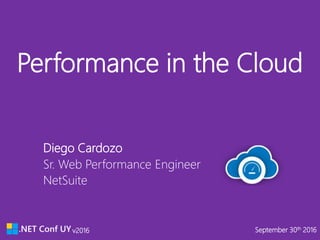Performance in the cloud
- 1. v2016 September 30th 2016v2016 September 30th 2016 Performance in the Cloud NetSuite Sr. Web Performance Engineer Diego Cardozo
- 2. v2016 September 30th 2016v2016 September 30th 2016 Agenda ŌĆó Why performance matters #perfmatters ŌĆó What to test ŌĆó How to test ŌĆó Performance on the cloud ŌĆó Test your cloud with local tools ŌĆó Test your cloud with cloud tools ŌĆó Let your users do the testing for you
- 3. v2016 September 30th 2016v2016 September 30th 2016 Why performance matters Why is it important for our business? ŌĆó Google: 2% slower = 2% less searches per user ŌĆó Yahoo: 400 ms faster = 9% more traffic ŌĆó Amazon: 100ms faster = 1% more revenue ŌĆó Google uses site speed in web search ranking Better performance ’āĀ Happier users ’āĀ More $
- 4. v2016 September 30th 2016v2016 September 30th 2016 What to test Classification of performance tests Type of test Goal Performance Determine and validate speed Load Verify application behavior under normal and peak load conditions Stress Verify application behavior beyond normal and peak load conditions Capacity Determine how many users and/or transactions are supported while meeting performance goals
- 5. v2016 September 30th 2016v2016 September 30th 2016 How to test There are only 2 rules 1. Measure first, then optimize 2. Repeat rule number 1 frequently
- 6. v2016 September 30th 2016v2016 September 30th 2016 What to test Have a goal ŌĆō 3 alternatives ŌĆó Performance Budget ŌĆó Twitter uses ŌĆ£time to first TweetŌĆØ ŌĆó Google created the RAIL model
- 7. v2016 September 30th 2016v2016 September 30th 2016 How to test 2 approaches ŌĆó Synthetic monitoring Emulate a user's browser, run a test case and register response times for all requests ŌĆó Real User Monitoring (RUM) Users passively send real performance data
- 8. v2016 September 30th 2016v2016 September 30th 2016 </talk> time to see some real toolsŌĆ”
- 9. v2016 September 30th 2016v2016 September 30th 2016 Synthetic monitoring ŌĆó Quick performance tests WebPage Test (free) ŌĆó Add load tests to your local dev suite Visual Studio Enterprise ’āĀ Load tests ŌĆó Run load tests from the cloud (free/paid) Visual Studio Team Services
- 10. v2016 September 30th 2016v2016 September 30th 2016 Real User Monitoring (RUM) Application Insights ŌĆō available for free on Azure ŌĆó Gather performance data from real users ŌĆó 360┬░ view of your application ŌĆó Server level ŌĆō IIS ŌĆó Application level ŌĆō SDK ’āĀ Telemetry data ŌĆó Client level ŌĆō data collection through JavaScript
- 11. v2016 September 30th 2016v2016 September 30th 2016 Application Insights ŌĆó Application performance monitoring Measure performance, discover failures ŌĆó Interactive data analytics Ad-hoc queries and deep diagnostics ŌĆó Proactive detection Machine learning based anomaly detection ŌĆó Not just .NET Java, Ruby, Python, PHP and Node.JS on Azure
- 12. v2016 September 30th 2016v2016 September 30th 2016 Resources and questions ŌĆó ║▌║▌▀Żs http://bit.ly/netconf-performance ŌĆó RAIL http://bit.ly/rail-performance ŌĆó MicrosoftŌĆÖs performance testing guide http://bit.ly/microsoft-performance dcardozo@netsuite.com @diecard












